Alexandre Néron's architecture master's final project, 'Spaces of Queer Connections,' explores the vital role of social spaces for queer communities. His project is aligned with the Night-time Design research group's focus on marginalized communities, particularly 2SLGBTQ+ groups, and the significance of nightclubs and bars as essential spaces for community-building and social sustainability.
Featured Spaces
- L'Androgyne Bookstore
- École Gilford
- Québec Gay Archives
- Queering the Night
- Espace LGBTQ+
- Evolution of Queer Connections
Spaces of Queer Connection is a highly personal research project stemming from my experience as a queer man. Despite being out for a decade, I grapple with the challenge of finding spaces for belonging and community. In this quest, I've discovered that I'm not alone; others on McGill's campus share similar experiences. Younger queer generations seem to yearn for community, cherishing a nostalgia for past generations who forged strong communities amid their fight for equality. The current political context emphasizes the crucial role of safe spaces for queer expression. The decline of 2SLGBTQ+ spaces over the past 20 years further highlights the significance of this research.
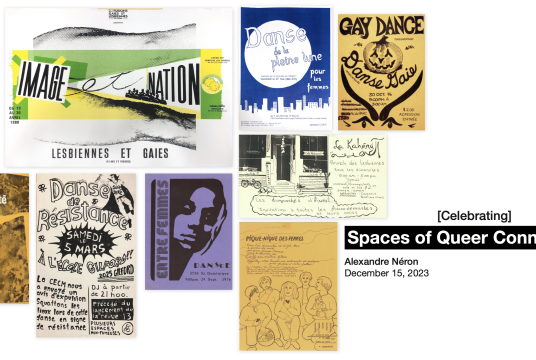
Project Context
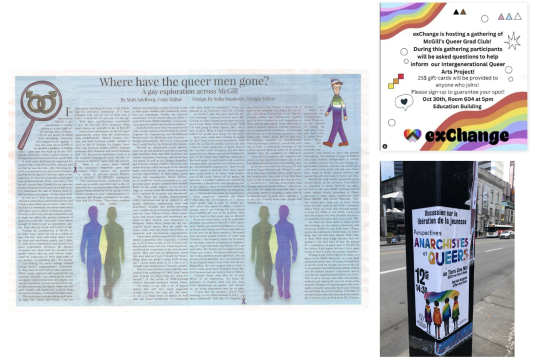


My personal struggle with queer connections prompted exploration on three fronts:
- Studying past communities through archival research to bridge connections between generations
- Engaging with current networks to break my isolation
- Envisioning future spaces that allow for self-expression and the feeling to ‘break free’
Memory Map

Montreal's historical material on LGBTQ+ communities is limited, highlighting the importance of resources like the Quebec Gay and Lesbian Archives. Key historical events showcase the themes of privacy/publicity for LGBTQ+ communities.

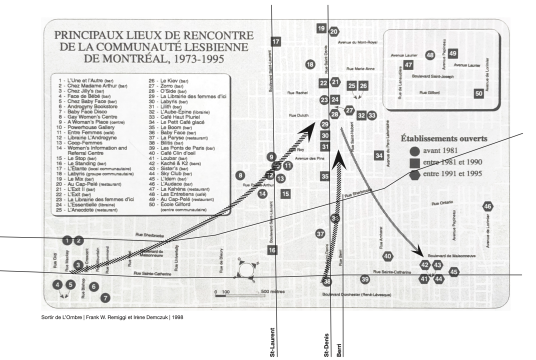

Gay and lesbian spaces initially coexisted downtown but diverged over time, posing challenges for fostering mixed spaces. Key spaces emerged during my research: L’Androgyne Bookstore, École Gilford, The Quebec Gay Archives, Queering the Night Event, and the Future Community Center: ‘Espace LGBTQ+’.
L'Androgyne Bookstore
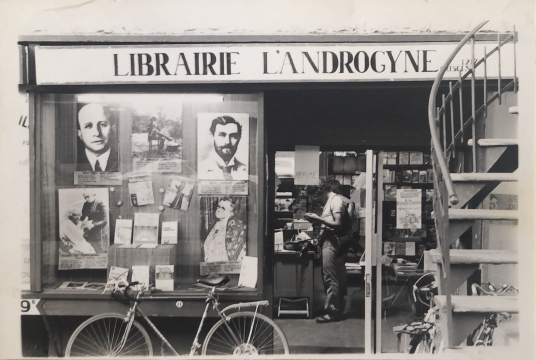
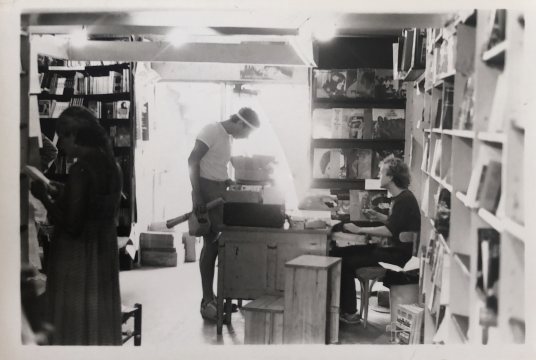


L’Androgyne Bookstore is significant as one of the first spaces that could be visible and cater to queer people in broad daylight. At its time, it was the only place people could go to obtain information on the gay and lesbian community and gain access to their hidden networks. I see this case study as an idealized space of queer connection. Its plan reveals how its book section programming attracts and brings exclusive groups near one another and allows them to experience togetherness while enjoying privacy.
École Gilford
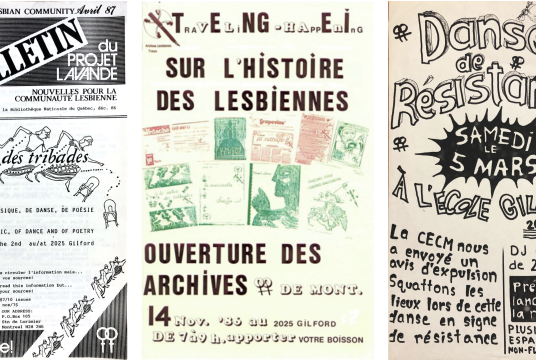


École Gilford, a prominent lesbian space from 1984 to 1994, remains a hidden chapter in lesbian history. Documented through posters and bulletins, it played a crucial role in artistic creation, pride, and activism. In contrast to L'Androgyne's inclusivity, École Gilford was exclusively for lesbians and their women friends. Its discreet entrance deliberately kept small and surrounded by bushes, offered a sense of freedom from external scrutiny. École Gilford's architectural design played a pivotal role in the performative nature of queer identities. The gymnasium, a vast space, hosted a diverse range of programs, fostering adaptability and transformation in response to community needs.
Québec Gay Archives

My frequent visits to the gay archive became a central aspect of my project's process. In a drawing, I aimed to capture the vibrant atmosphere of the archive—a space buzzing with people where every visit resulted in new connections. Each frame highlights elements that make this queer space unique, emphasizing its proud yet private nature. Surrounded by historical materials, including symbolic artifacts like the infamous pink balls, the experience bridges personal history with generational narratives. The single table fosters intimate conversations, and the tactile interaction with archival material immerses visitors in history, fostering a mindset of openness. Continuous programming encourages intergenerational connections, creating a dynamic and ever-evolving space.
Queering the Night





Events hosted as part of Night-time Design for Marginalized Communities shifted the project's focus from studying past spaces to actively creating future spaces of queer connections. The emphasis lies on togetherness and privacy. The workshop explored the significance of queer spaces and the challenges and opportunities for inclusivity. These insights contribute to the vision of creating welcoming environments for the LGBTQ+ community. In the workshop's second part, participants collectively envisioned utopian spaces, emphasizing shared dreams for a more inclusive world. Participant’s motivation in the workshop showed me how important creating spaces for ourselves is important.
Espace LGBTQ+

Over the last two decades, various attempts were made to establish a queer community center, but many were unsuccessful. In 2019, Espace LGBTQ+ was founded, and since then, it has collaborated closely with community organizations, addressing needs and securing financing. In a significant development, they acquired a space in the village at the end of the summer. Having recently connected with them, I discovered they are in the initial stages of envisioning the future center with their architects. The upcoming semester presents an opportune time for collaboration, aligning perfectly with their timeline for recommendations before the center's conception and planning commence in April.

Espace LGBTQ+'s objectives focus on resource-sharing among organizations. Until March, Entremise is consulting with participating groups to explore shared spaces like coworking areas, meeting rooms, private consultation rooms, admin resources, and facade access. Excitement arises about integrating my project into the broader LGBTQ+ communities. Successful spaces of queer connections thrive when supported by the community. If there's enthusiasm for activities beyond organizational use, the center can become a true community hub. I'll work alongside Entremise, conducting research and making recommendations on integrating purpose-built spaces of queer connections, shared programs, and strategic entrance/facade designs for a comprehensive community-centric approach.
Evolution of Queer Connections
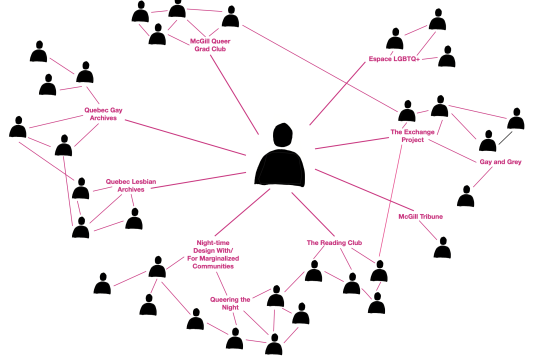
In reflecting on the semester's journey, the initial struggle to find spaces of belonging has evolved into a vibrant network of connections within the LGBTQ+ community. Through this project, meaningful dialogues have been initiated, and connections with numerous queer individuals have been established. This journey is only the beginning, and the process has been transformative.